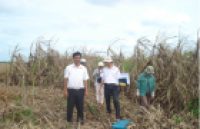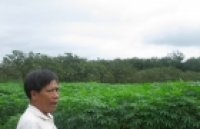| Uncovering Novel QTLs and Candidate Genes for Salt Tolerance at the Bud Burst Stage in Rice through Genome-Wide Association Study |
|
Salt stress is one of the most important factors limiting rice growth and yield increase. Salt tolerance of rice at the bud burst (STB) stage determines whether germinated seeds can grow normally under salt stress, which is very important for direct seeding. However, reports on quantitative trait loci (QTLs) and candidate genes for STB in rice are very limited. In this study, a natural population of 130 indica and 81 japonica rice accessions was used to identify STB-related QTLs and candidate genes using a genome-wide association study (GWAS). |
|
Caijing Li, Changsheng Lu, Mengmeng Yang, Guangliang Wu, Mvuyeni Nyasulu, Haohua He, Xiaopeng He, Jianmin Bian Plants (Basel); 2024 Jan 8; 13(2):174. doi: 10.3390/plants13020174. AbstractSalt stress is one of the most important factors limiting rice growth and yield increase. Salt tolerance of rice at the bud burst (STB) stage determines whether germinated seeds can grow normally under salt stress, which is very important for direct seeding. However, reports on quantitative trait loci (QTLs) and candidate genes for STB in rice are very limited. In this study, a natural population of 130 indica and 81 japonica rice accessions was used to identify STB-related QTLs and candidate genes using a genome-wide association study (GWAS). Nine QTLs, including five for relative shoot length (RSL), two for relative root length (RRL), and two for relative root number (RRN), were identified. Five of these STB-related QTLs are located at the same site as the characterized salt tolerance genes, such as OsMDH1, OsSRFP1, and OsCDPK7. However, an important QTL related to RSL, qRSL1-2, has not been previously identified and was detected on chromosome 1. The candidate region for qRSL1-2 was identified by linkage disequilibrium analysis, 18 genes were found to have altered expression levels under salt stress through the RNA-seq database, and 10 of them were found to be highly expressed in the shoot. It was also found that, eight candidate genes (LOC_Os01g62980, LOC_Os01g63190, LOC_Os01g63230, LOC_Os01g63280, LOC_Os01g63400, LOC_Os01g63460, and LOC_Os01g63580) for qRSL1-2 carry different haplotypes between indica and japonica rice, which exactly corresponds to the significant difference in RSL values between indica and japonica rice in this study. Most of the accessions with elite haplotypes were indica rice, which had higher RSL values. These genes with indica-japonica specific haplotypes were identified as candidate genes. Rice accessions with elite haplotypes could be used as important resources for direct seeding. This study also provides new insights into the genetic mechanism of STB.
See https://pubmed.ncbi.nlm.nih.gov/38256728/
Figure 1: Phenotypic displays of four randomly selected rice varieties from the natural population after seven days of control and salt stress.
|
|
|
|
[ Tin tức liên quan ]___________________________________________________
|


 Curently online :
Curently online :
 Total visitors :
Total visitors :
(272).png)


